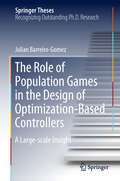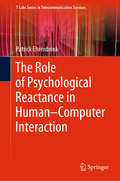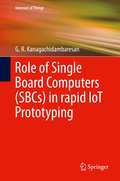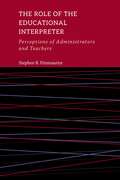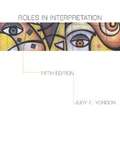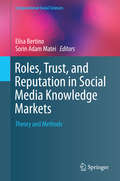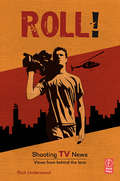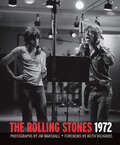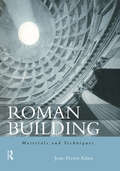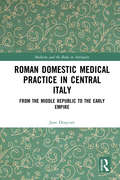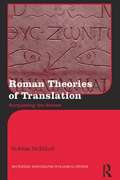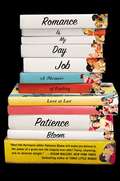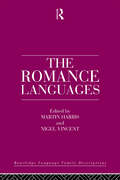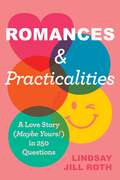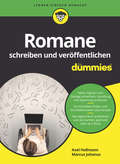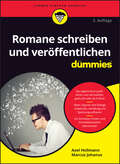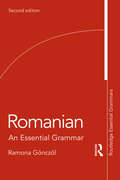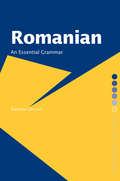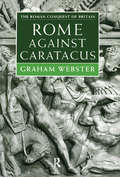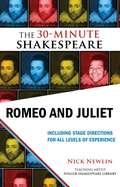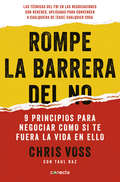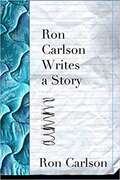- Table View
- List View
The Role of Population Games in the Design of Optimization-Based Controllers: A Large-scale Insight (Springer Theses)
by Julian Barreiro-GomezThis book reports on the implementation of evolutionary-game theory in the design of distributed optimization-based controllers. First, it discusses how the classical population-game approach can contribute to and complement the design of optimization-based controllers. It shows how the features of this approach can be exploited to extend their capabilities in the solution of distributed optimization problems, and examines density games in order to consider multiple coupled constraints and preserve the non-centralized information requirements. Furthermore, it establishes a close relationship between the possible interactions among agents in a population with constrained information sharing among different local controllers. It also discusses coalitional games, focusing on the Shapley power index and proposes an alternative method of computing the latter, which reduces computational time, as well as a different way of finding it using distributed communication structures. All the proposed strategies are then tested on various control problems, such as those related to the Barcelona water supply network, multiple continuous stirred tank reactors, various unmanned aerial vehicle systems, and a water distribution system. This thesis, examined at the Universitat Politècnica de Catalunya and Universidad de los Andes in 2017, received the award for best thesis in control from the control group of the Spanish Committee of Automatic Control (CEA) in the same year.
The Role of Psychological Reactance in Human–Computer Interaction (T-Labs Series in Telecommunication Services)
by Patrick EhrenbrinkThis book provides an in-depth investigation on the psychological phenomenon "reactance“ in the context of Human-Computer Interaction (HCI). The author argues that the complexity and autonomy of modern technology can sometimes be overwhelming and can then be perceived as a threat to freedom by its users, thereby diminishing acceptance. The book investigates if and how this is the case and provides strategies to regain the lost acceptance. Topics include relevance of reactance on HCI, triggers for reactance, consequences of reactance, measurement of reactance, and countermeasures to reactance.
Role of Single Board Computers (Internet of Things)
by G. R. KanagachidambaresanThis book presents how to program Single Board Computers (SBCs) for Internet of Things (IoT) rapid prototyping with popular tools such as Raspberry Pi, Arduino, Beagle Bone, and NXP boards. The book provides novel programs to solve new technological real-time problems. The author addresses programming, PCB design and Mechanical Cad design all in single volume, easing learners into incorporating their ideas as prototype. The aim of the book is to provide programming, sensors interfacing, PCB design, and Mechanical Cad design to and create rapid prototyping. The author presents the methodologies of rapid prototyping with KiCAD design and Catia software, used to create ready to mount solutions. The book covers scripting- based and drag/drop- based programming for different problems and data gathering approach.
The Role of the Arab-Islamic World in the Rise of the West
by Nayef R. F. Al-RodhanThis book takes a fascinating look at the role of the Arab-Islamic world in the rise of the West. It examines the cultural transmission of ideas and institutions in a number of key areas, including science, philosophy, humanism, law, finance, commerce, as well as the Arab-Islamic world's overall impact on the Reformation and the Renaissance.
The Role of the Educational Interpreter: Perceptions of Administrators and Teachers (The Interpreter Education Series #11)
by Stephen B. FitzmauriceWhile educational interpreting has been studied for decades, the research has historically focused on the tasks educational interpreters are engaged in during their work day. In The Role of the Educational Interpreter, Stephen B. Fitzmaurice takes a new approach using role theory to examine how administrators and teachers perceive the role and work of educational (K–12) interpreters. Through a series of qualitative interviews and quantitative questionnaires with district administrators, school administrators, general education teachers, and teachers of the deaf, Fitzmaurice documents their perceptions of educational interpreters. Findings from the data reveal the perceptions of administrators and teachers set the stage for role ambiguity, role conflicts, and subsequent role overload for educational interpreters. Fitzmaurice elaborates on the implications of the research, and also provides concrete recommendations for researchers and practitioners, including an emphasis on the importance of involving the Deaf community in this work. This volume aims to offer clarity on the role of the educational interpreter, and dispel the confusion and conflicts created by divergent perspectives. A shared understanding of the role of the educational interpreter will allow administrators, teachers, and interpreters to work collaboratively to improve educational outcomes for deaf students.
Roles in Interpretation (Fifth Edition)
by Judy E. YordonInterpretation is an artistic process of studying literature through performance and sharing that study with an audience. Yordon's Roles in Interpretation prepares students for the roles they will play in performances by explaining interpretation through a wide variety of literary forms, performance styles, and recent theories of interpretation.
Roles, Trust, and Reputation in Social Media Knowledge Markets
by Elisa Bertino Sorin Adam MateiKnowledge and expertise, especially of the kind that can shape public opinion, have been traditionally the domain of individuals holding degrees awarded by higher learning institutions or occupying formal positions in notable organizations. Expertise is validated by reputations established in an institutionalized marketplace of ideas with a limited number of "available seats" and a stringent process of selection and retention of names, ideas, topics and facts of interest. However, the social media revolution, which has enabled over two billion Internet users not only to consume, but also to produce information and knowledge, has created a secondary and very active informal marketplace of ideas and knowledge. Anchored by platforms like Wikipedia, YouTube, Facebook and Twitter, this informal marketplace has low barriers to entry and has become a gigantic and potentially questionable, knowledge resource for the public at large. Roles, Trust and Reputation in Social Media Knowledge Markets will discuss some of the emerging trends in defining, measuring and operationalizing reputation as a new and essential component of the knowledge that is generated and consumed online. The book will propose a future research agenda related to these issues. The ultimate goal of research agenda being to shape the next generation of theoretical and analytic strategies needed for understanding how knowledge markets are influenced by social interactions and reputations built around functional roles. The authors, including leading scholars and young innovators, will share with the readers some of the main lessons they have learned from their own work in these areas and will discuss the issues, topics and sub-areas that they find under-studied or that promise the greatest intellectual payoff in the future. The discussion will be placed in the context of social network analysis and "big data" research. Roles, Trust and Reputation in Social Media Knowledge Markets exposes issues that have not been satisfactorily dealt with in the current literature, as the research agenda in reputation and authorship is still emerging. In a broader sense, the volume aims to change the way in which knowledge generation in social media spaces is understood and utilized. The tools, theories and methodologies proposed by the contributors offer concrete avenues for developing the next generation of research strategies and applications that will help: tomorrow's information consumers make smarter choices, developers to create new tools and researchers to launch new research programs.
Roll! Shooting TV News: Views from Behind the Lens
by Rich UnderwoodRoll! Shells fly overhead as night-scopes capture deadly fire fights with an eerie green hue, a category 5 hurricane devastates the Big Easy, hidden cameras enter a Cambodian village of brothels and a veteran journalist interviews himself throughout his own brain surgery. Part non-fiction drama, part trade publication, part text book, all woven together giving the reader a look through the viewfinders of the very best television photojournalists. As 19 experts weigh in with their candid, personal stories and photographic tips, it's as if you're over their shoulders, following their intuitions and hearing their thoughts as they shoot. The trade term for what they do is called ENG (Electronic News Gathering) and whether they're called Cameramen, Backpack Journalists, Television Photographers or any other moniker de jour, they're all paid to bring the world's events into living rooms around the world. These are the men and women who capture the bleeding edge of history - as it happens.Written in a smooth, unique interview style, this book is a necessary read for photojournalists, videographers and tv photojournalists.
The Rolling Stones 1972
by Jim MarshallA pictorial chronicle of the Stones’ classic summer concert tour from the Life magazine photographer who followed them—with a foreword by Keith Richards.In 1972, the Rolling Stones marked their first decade as a band with the release of Exile on Main St. and a summer concert tour of America that set new standards for magnificence in live performance. Covering the tour for Life magazine, photographer Jim Marshall captured indelible moments of the Stones in their glory onstage, as well as the camaraderie behind the scenes. Featuring a foreword by Keith Richards, this volume presents Marshall’s shots alongside dozens of never-before-seen frames. Stones fans will revel in this unprecedented look at one of the biggest rock bands of all time from the photographer who captured them best.“The stunning images in this collection show the Stones in all their strung-out Exile on Main Street-era splendor—recording in Los Angeles, chilling backstage and strutting across some very lucky concert stages.” —Rolling Stone
Roman Building: Materials and Techniques
by Jean-Pierre AdamWith over 750 illustrations, Roman Buildings is a thorough and systematic examination of Roman architecture and building practice, looking at large-scale public buildings as well as more modest homes and shops. Placing emphasis on the technical aspects of the subject, the author follows the process of building through each stage -- from quarry to standing wall, from tree to roof timbers -- and describes how these materials were obtained or manufactured. The author also discusses interior decoration and looks at the practical aspects of water supply, heating and roads.
Roman Domestic Medical Practice in Central Italy: From the Middle Republic to the Early Empire (Medicine and the Body in Antiquity)
by Jane DraycottRoman Domestic Medical Practice in Central Italy examines the roles that the home, the garden and the members of the household (freeborn, freed and slave) played in the acquisition and maintenance of good physical and mental health and well-being. Focussing on the period from the middle Republic to the early Empire, it considers how comprehensive the ancient Roman general understanding of health actually was, and studies how knowledge regarding various aspects of health was transmitted within the household. Using literary, documentary, archaeological and bioarchaeological evidence from a variety of contexts, this is the first extended volume to provide as comprehensive and detailed a reconstruction of this aspect of ancient Roman private life as possible, complementing existing works on ancient professional medical practice and existing works on domestic medical practice in later historical periods. This volume offers an indispensable resource to social historians, particularly those that focus on the ancient family, and medical historians, particularly those that focus on the ancient world.
Roman Theories of Translation: Surpassing the Source (Routledge Monographs in Classical Studies)
by Siobhán McElduffFor all that Cicero is often seen as the father of translation theory, his and other Roman comments on translation are often divorced from the complicated environments that produced them. The first book-length study in English of its kind, Roman Theories of Translation: Surpassing the Source explores translation as it occurred in Rome and presents a complete, culturally integrated discourse on its theories from 240 BCE to the 2nd Century CE. Author Siobhán McElduff analyzes Roman methods of translation, connects specific events and controversies in the Roman Empire to larger cultural discussions about translation, and delves into the histories of various Roman translators, examining how their circumstances influenced their experience of translation. This book illustrates that as a translating culture, a culture reckoning with the consequences of building its own literature upon that of a conquered nation, and one with an enormous impact upon the West, Rome's translators and their theories of translation deserve to be treated and discussed as a complex and sophisticated phenomenon. Roman Theories of Translation enables Roman writers on translation to take their rightful place in the history of translation and translation theory.
Romance Is My Day Job
by Patience BloomWho knows the ins and outs of romance better than a Harlequin editor? A surprising and exhilarating look into Patience Bloom's unexpected real-life love story. At some point, we've all wished romance could be more like fiction. Patience Bloom certainly did, many times over. As a teen she fell in love with Harlequin novels and imagined her life would turn out just like the heroines' on the page: That shy guy she had a crush on wouldn't just take her out--he'd sweep her off her feet with witty banter, quiet charm, and a secret life as a rock star. Not exactly her reality, but Bloom kept reading books that fed her reveries. Years later she moved to New York and found her dream job, editing romances for Harlequin. Every day, her romantic fantasies came true--on paper. Bloom became an expert when it came to fictional love stories, editing amazing books and learning everything she could about the romance business. But her dating life remained uninspired. She nearly gave up on love. Then one day a real-life chance at romance made her wonder if what she'd been writing and editing all those years might be true. A Facebook message from a high school friend, Sam, sparked a relationship with more promise than she'd had in years. But Sam lived thousands of miles away--they hadn't seen each other in more than twenty years. Was it worth the risk? Finally, Bloom learned: Love and romance can conquer all.
The Romance Languages: Volume 1, Structures (Routledge Language Family Series)
by Nigel Vincent Martin HarrisAvailable again, this book discusses nine Romance languages in context of their common Latin origins and then in individual studies. The final chapter is devoted to Romance-based Creole languages; a genuine innovation in a work of this kind.
Romances & Practicalities: A Love Story (Maybe Yours!) in 250 Questions
by Lindsay Jill RothWith the pop psychology of Malcolm Gladwell and the humor of Carrie Bradshaw, Romances & Practicalities combines a charming personal love story with research-backed self-help, including a set of 250 questions to help you foster deeper intimacy and get honest about what you’re really looking for in a partner.A few months into Lindsay Jill Roth’s whirlwind transatlantic courtship with a handsome Englishman, he made a comment that hit her like a gut-punch: “I don’t know you well enough yet.” Despite hours on FaceTime and swoon-worthy dates in London and NYC, Roth realized he was right: they didn’t know each other very well. And their relationship, while certainly romantic, was hardly practical. Did they even have a shared vision for the future? In the age of increasingly impersonal dating, how do you get off the dating hamster wheel and advance a relationship along the path to commitment? How do you know if you’re with “the one"?Enter Romances & Practicalities, a set of 250 research-backed questions spread across twelve categories—from money to children to chores to sex—designed to help you identify your wants, needs, and non-negotiables, assess compatibility, initiate tricky conversations with grace, and build a deeper, stronger relationship. Questions range from seemingly light and casual to intimate and serious, including:How did your family communicate, share, and argue growing up?How are we different? Might our differences be a source of future conflict?How important to you is alone-time?How important is your career in terms of your identity?How do you feel about debt? Mortgages?If we were stuck on a desert island, what strengths would you bring to help us survive?Roth weaves the questions with her own love story, provocative interviews with couples who’ve used the system, and practical guidance from a diverse range of clinical and popular experts including Lori Gottlieb, Nicole LePera, Mark Hyman, Emily Morse, Suze Orman, Nate Berkus, and Barbara Corcoran.Roth’s wise and witty narrative explores the reasons we don’t often equate romance with practicality, and arrives at a surprising truth: healthy communication isn’t just vital, it’s sexy.
Romane schreiben und veröffentlichen für Dummies (Für Dummies)
by Axel Hollmann Marcus JohanusHaben Sie auch schon einmal mit dem Gedanken gespielt, Ihren eigenen Roman zu schreiben? Dieses Buch begleitet Sie auf Ihrem Weg als Schriftsteller. Axel Hollmann und Marcus Johanus helfen Ihnen, faszinierende Buchideen zu entwickeln, interessante Figuren zu erfinden, fesselnde Dialoge zu schreiben und spannende Handlungsbögen aufzubauen. Außerdem finden Sie in diesem Buch das wichtigste Handwerkszeug, das Sie als Romanautor beherrschen sollten und Möglichkeiten, Ihr Buch als gedrucktes Buch oder E-Book, im Selfpublishing oder bei einem Verlag zu publizieren und zu vermarkten.
Romane schreiben und veröffentlichen für Dummies (Für Dummies)
by Axel Hollmann Marcus JohanusRomane schreiben und veröffentlichen Finden Sie den Roman in sich Haben Sie auch schon einmal mit dem Gedanken gespielt, Ihren eigenen Roman zu schreiben? Dieses Buch begleitet Sie auf Ihrem Weg als Schriftsteller. Axel Hollmann und Marcus Johanus helfen Ihnen, faszinierende Buchideen zu entwickeln, interessante Figuren zu erfinden, fesselnde Dialoge zu schreiben und spannende Handlungsbögen aufzubauen. Außerdem finden Sie in diesem Buch das wichtigste Handwerkszeug, das Sie als Romanautor beherrschen sollten, und Möglichkeiten, Ihren Roman als gedrucktes Buch oder E-Book, im Selfpublishing oder bei einem Verlag zu publizieren und zu vermarkten. Sie erfahren Was es über Drei-Akte-Struktur, Heldenreise und Erzählperspektive zu wissen gibt Wie Sie Ihr Werk überarbeiten Was Sie von Agenten und Verlagen erwarten können Wie Sie sich in den sozialen Medien präsentieren
Romanian: An Essential Grammar (Routledge Essential Grammars)
by Ramona GönczölNow in its second edition, Romanian: An Essential Grammar is a concise, user-friendly guide to modern Romanian. It takes the student through the essentials of the language, explaining each concept clearly and providing many examples of contemporary Romanian usage. This fully revised second edition contains: • a chapter of each of the most common grammatical areas with Romanian and English examples • extensive examples of the more difficult areas of the grammar • a section with exercises to consolidate the learning and the answer key • a list of useful verbs • an appendix listing useful websites for further information • a glossary of grammatical terms used in the book • a useful bibliographical list. Suitable for both classroom use and independent study, this book is ideal for beginner to intermediate students.
Romanian: An Essential Grammar (Routledge Essential Grammars)
by Ramona GönczölThis book is suitable for independent and classroom learners, ideal for the beginner to intermediate student, and takes the reader through the essentials of the language explaining each concept clearly and providing many examples of contemporary Romanian usage. The book contains: a chapter on each of the most common grammatical areas with Romanian and English examples extensive examples of the more difficult areas of the grammar an appendix listing relevant websites for further information on the Romanian language.
The Romantic Crowd
by Mary FaircloughIn the long eighteenth century, sympathy was understood not just as an emotional bond, but also as a physiological force, through which disruption in one part of the body produces instantaneous disruption in another. Building on this theory, Romantic writers explored sympathy as a disruptive social phenomenon, which functioned to spread disorder between individuals and even across nations like a 'contagion'. It thus accounted for the instinctive behaviour of people swept up in a crowd. During this era sympathy assumed a controversial political significance, as it came to be associated with both riotous political protest and the diffusion of information through the press. Mary Fairclough reads Edmund Burke, Mary Wollstonecraft, William Godwin, John Thelwall, William Hazlitt and Thomas De Quincey alongside contemporary political, medical and philosophical discourse. Many of their central questions about crowd behaviour still remain to be answered by the modern discourse of collective psychology.
Romantic Readers: The Evidence of Marginalia
by H. J. JacksonWhen readers jot down notes in their books, they reveal something of themselves--what they believe, what amuses or annoys them, what they have read before. But a close examination of marginalia also discloses diverse and fascinating details about the time in which they are written. This book explores reading practices in the Romantic Age through an analysis of some 2,000 books annotated by British readers between 1790 and 1830. This period experienced a great increase in readership and a boom in publishing. H. J. Jackson shows how readers used their books for work, for socializing, and for leaving messages to posterity. She draws on the annotations of Blake, Coleridge, Keats, and other celebrities as well as those of little known and unknown writers to discover how people were reading and what this can tell us about literature, social history, and the history of the book.
Rome Against Caratacus: The Roman Campaigns in Britain AD 48-58
by Graham WebsterThe Roman Conquest of Britain in AD 43 was one of the most important turning points in the history of the British Isles. It left a legacy still discernible today in the form of archaeological remain, road networks, land divisions and even language.In his much-acclaimed trilogy, now up-dated and revised, Dr Webster builds up a fascinating and lively picture of Britain in the first century AD and discussed in detail the various types of evidence and the theories based upon it.Caratacus' last stand against the Romans has a central place in the folklore of the Welsh Marches, where many a hill is claimed to be the site of the famous battle. But, as Graham Webster shows, this epic encounter was not only real history but also part of an intricate ten-year series of campaigns conducted after the initial conquest of Britain.By interpreting the ancient historical accounts and piecing together the masses of archaeological evidence, Dr Webster has brilliantly reconstructed this central period of the Claudian Conquest of Britain and its immediate aftermath.
Romeo and Juliet: The 30-Minute Shakespeare
by Nick NewlinPlanning a school or amateur Shakespeare production? The best way to experience the plays is to perform them, but getting started can be a challenge: The complete plays are too long and complex, while scene selections or simplified language are too limited."The 30-Minute Shakespeare" is a new series of abridgements that tell the "story" of each play from start to finish while keeping the beauty of Shakespeare's language intact. Specific stage directions and character suggestions give even inexperienced actors the tools to perform Shakespeare with confidence, understanding, and fun!This cutting of ROMEO AND JULIET is edited to four key scenes, starting with the lyrical prologue and the foreboding opening brawl, which is played out in slow motion to music. Also included are the timeless balcony scene; the harsh scolding of Juliet by her father; and the final moments at the tomb.The edition also includes an essay by editor Nick Newlin on how to produce a Shakespeare play with novice actors, and notes about the original production of this abridgement at the Folger Shakespeare Library's annual Student Shakespeare Festival.
Rompe la barrera del no: 9 principios para negociar como si te fuera la vida en ello
by Chris VossEl prestigioso ex negociador internacional del FBI Chris Voss, especializado en secuestros con rehenes, nos enseña un método de negociación rompedor: tácticas para negociaciones duras que son aplicables en múltiples aspectos de nuestras vidas. Rompe la barrera del no es un manual de negociación imprescindible desarrollado y perfeccionado a lo largo de la extraordinaria carrera de Chris Voss como negociador en secuestros con rehenes y como reconocido profesor en las escuelas de negocio más prestigiosas del mundo. Voss ha puesto a prueba estas técnicas en todo tipo de situaciones y ha comprobado su efectividad, tanto en los inicios de su carrera cuando patrullaba las peligrosas calles de Kansas City como en los cursos que imparte en las mejores universidades. Entre las muchas y distintas personas que han aplicado sus enseñanzas, se encuentran desde clientes que han visto aumentar significativamente los beneficios de sus empresas hasta estudiantes de programas de MBA que han conseguido empleos mejores o incluso padres que tienen que vérselas con sus hijos. Rompe la barrera del no relata los entresijos de situaciones verdaderamente dramáticas y revela las mejores y más eficaces estrategias de negociación. Voss, uno de los mejores negociadores del mundo, nos enseña a emplear estas técnicas en cualquier aspecto de nuestra vida. Reseñas:«Este libro destaca la importancia de la inteligencia emocional sin sacrificar la necesidad de conseguir acuerdos. Escrito por un negociador de rehenes, alguien que no se podía permitir una respuesta negativa, este libro resulta una lectura fascinante y muy práctica. En él encontraremos las técnicas necesarias para alcanzar el acuerdo deseado.»Daniel H. Pink, autor del bestseller Vender es humano «Pocas personas gozan de la experiencia de Chris Voss, ex negociador del FBI en situaciones de secuestros con rehenes. Sus técnicas funcionan, tanto para los negocios como para la vida.»Joe Navarro, agente especial (retirado) del FBI y autor del bestseller internacional El cuerpo habla «Los negocios, y prácticamente todo en la vida, dependen de cómo encaramos determinadas conversaciones cruciales, y estas herramientas nos proporcionan la ventaja que necesitamos... Es una lectura obligatoria para mis empleados, porque yo utilizo las lecciones de este libro cada día, y me gustaría que ellos también lo hicieran.»Jason MacCarthy, CEO de Goruck
Ron Carlson Writes A Story
by Ron CarlsonRon Carlson has been praised as "a master of the short story" (Booklist). In this essay collection, Ron Carlson Writes a Story, he offers a full range of notes and gives rare insight into a veteran writer's process by inviting the reader to watch over his shoulder as he creates the short story "The Governor's Ball." <p><p> "This is a story of a story" he begins, and proceeds to offer practical advice for creating a great story, from the first glimmer of an idea to the final sentence. Carlson urges the writer to refuse the outside distractions―a second cup of coffee, a troll through the dictionary―and attend to the necessity of uncertainty, the pleasures of an unfolding story. <p><p> "The Governor's Ball"―included in its entirety―serves as a fascinating illustration of the detailed anatomy of a short story.
